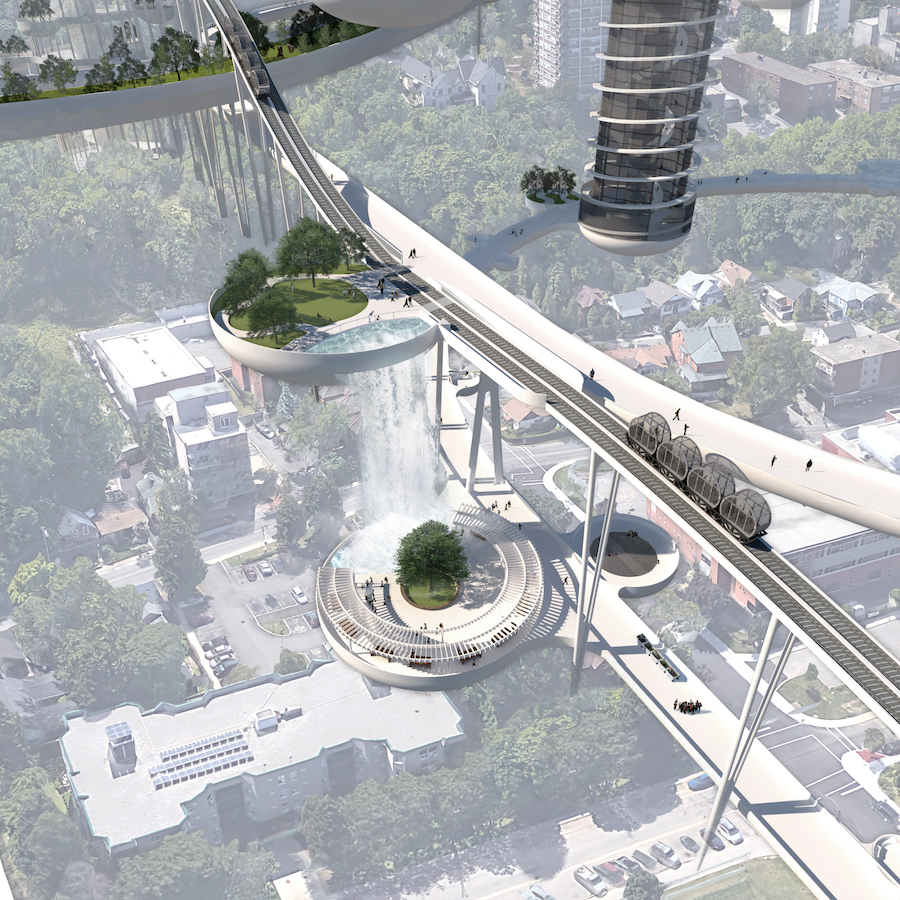Hamilton architects propose futuristic, waterfall-studded green tower
Hamilton architects DPAI have proposed a futuristic green tower at the intersection of a six-lane highway and the Niagara Escarpment. The conceptual project—called Fibroblast Tower— imagines an intervention whereby architecture is used to heal physical, urban, environmental, and socio-political wounds from the past. “This is one of our efforts to create and elevate a better public dialogue about design in Hamilton,” says DPAI Principal and CEO David Premi.
The Fibroblast Tower is a prosthetic intervention that is designed to begin the healing process of a natural ecosystem, the Niagara Escarpment. Seen as a barrier, the residents of the City of Hamilton have attempted to conquer this World Biosphere Refuge by scarring its surface with roads, paths, and funicular railways to overcome travel challenges. The result is a dysfunctional relationship where the escarpment has become a symbol of the City’s political and environmental shortcomings.

The Niagara escarpment
The Niagara Escarpment was the result of unequal erosion. Over time, the soft rocks weather away or erode by the action of streams. The gradual removal of the soft rocks undercuts the resistant caprock, leaving a cliff or escarpment that runs predominantly east/west from New York, through Ontario, Michigan, Wisconsin, and Illinois.
The escarpment is both a connector and a divider. It connects land and water, nations, urban and rural environments along its length. It provides a conduit for wildlife. The Bruce Trail runs the length of the escarpment from Queenston on the Niagara River to Tobermory on the Bruce Peninsula, providing a venue for uninterrupted nature walks of 890 kilometers in length. The breadth of the escarpment divides the environments above and below, creating a barrier for travel and movement of goods.
The Niagara Escarpment is a UNESCO designated World Biosphere Reserve and is heavily protected from further damage caused by roads, ski areas, resorts, railways, buildings, and wind farms.

Historical interventions and wounds in Hamilton
The city of Hamilton intersects with the escarpment in such a way that the north end of the city is below and the south part above. Affectionately referred to as “The Mountain” by its residents, many roads or “mountain accesses” join the urban core below with the suburban expansion above. The escarpment has thus become a living metaphor for the deep political and cultural schism between the urban and suburban residents of the city.
In Hamilton, surface roads bridging the upper and lower cities are badly eroded and require constant maintenance. As a geological feature that’s still forming, the Niagara escarpment is a very active land feature. A failure to understand falling rocks and erosion are an immutable geologic process has resulted in a chronic “colonized wound” – exacerbated by pathogenic automobile traffic and political divisiveness, making healing difficult.

Healing: Fibroblast Tower
The Fibroblast Tower plays both a practical and symbolic role in healing the practical, physical, social and political divisions that the escarpment exacerbates. It accommodates pedestrian, automobile and public transportation, while connecting cycling infrastructure above and below. It reconnects the wildlife highway and provides new bird habitats to support the natural ecosystem. It allows the escarpment to live, breathe, and erode as a living landform, in harmony with the animal and human inhabitants that live near or on it.

The habitable environments in the tower provide democratic and universal access to multi-modal transportation, recreation, and spectacular views for all residents, regardless of ability or whether they live in the upper or lower city. More importantly, it allows opportunities for upper and lower city dwellers to commune with one another on many different levels.
As the tallest free-standing structure in the region, it will be visible from many vantage points on land and water more than 100 kilometers away. It serves as an important symbolic landmark of a newly unified, connected, and healing city.
